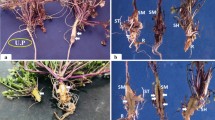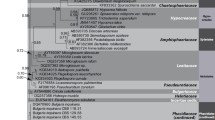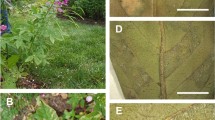Abstract
Teratosphaeria suttonii (=Kirramyces epicoccoides) is a leaf pathogen that can cause premature defoliation, reduced growth and vigor, and subsequent tree death of many Eucalyptus species. Although the fungus primarily infects mature leaves in the lower canopy, infections can spread to younger leaves during continued epidemics or when trees are stressed. Teratosphaeria suttonii has a wide distribution in Australia and has been introduced to many other parts of the world, most probably with germplasm used to establish plantations. The aim of this study was to establish the phylogenetic relationships between T. suttonii isolates from different countries and to consider whether cryptic species exist in a species complex. DNA from parts of the nuclear ribosomal internal transcribed spacer, β-tubulin, and elongation factor-1α genes was sequenced and analyzed for isolates from throughout the range of T. suttonii in Australia, and from six countries (China, Indonesia, South Africa, Uruguay, United States, and Vietnam) where the pathogen is introduced. Morphometrics of conidia produced both in vivo and in vitro were also considered. Analysis of the sequence data resulted in incongruent genealogies. Furthermore, groups of isolates in the genealogies could not be linked to area of origin. Similarly, differences in conidial morphology could not be linked to any of the phylogenetic groups. There was no evidence of distinct species boundaries, and isolates from Australia were closely related to those from other parts of the world. The results of this study support the treatment of T. suttonii as a morphologically and genetically diverse species in its natural range in Australia. The diversity is reflected in introduced populations.




Similar content being viewed by others
References
Andjic V, Barber PA, Carnegie AJ, Pegg GS, Hardy GESJ, Wingfield MJ, Burgess TI (2007a) Kirramyces viscidus sp. nov., a new eucalypt pathogen from tropical Australia closely related to the serious leaf pathogen, Kirramyces destructans. Australas Plant Pathol 36:478–487
Andjic V, Hardy GESJ, Cortinas MN, Wingfield MJ, Burgess TI (2007b) Multiple gene genealogies reveal important relationships between species of Phaeophleospora infecting Eucalyptus leaves. FEMS Microbiol Lett 268:22–33
Andjic V, Pegg GS, Carnegie AJ, Callister A, Hardy GESJ, Burgess TI (2010) Teratosphaeria pseudoeucalypti, new cryptic species responsible for leaf blight of Eucalyptus in subtropical and tropical Australia. Plant Pathol 59:900–912
Andjic V, Dell B, Barber PA, Hardy G, Wingfield M, Burgess TI (2011) Plants for planting; indirect evidence for the movement of a serious forest pathogen, Teratosphaeria destructans, in Asia. Eur J Plant Pathol 131(1):49–58
Benyon FHL, Burgess L, Sharp P (2000) Molecular genetic investigations and reclassification of Fusarium species in sections Fusarium and Roseum. Mycol Res 104:1164–1174
Burgess TI, Wingfield MJ (2002a) Impact of fungal pathogens in natural forest ecosystems: a focus on Eucalyptus. In: Sivasithamparam K, Dixon KW (eds) Microorganisms in plant conservation and biodiversity. Kluwer, Dordrecht, pp 285–306
Burgess TI, Wingfield MJ (2002b) Quarantine is important in restricting the spread of exotic seed-borne tree pathogens in the southern hemisphere. Int For Rev 4(1):56–65
Burgess TI, Andjic V, Hardy GESJ, Dell B, Xu D (2006) First report of Phaeophleospora destructans in China. J Trop For Sci 18:144–146
Burgess TI, Andjic V, Wingfield MJ, Hardy GESJ (2007) The eucalypt leaf blight pathogen Kirramyces destructans discovered in Australia. Australas Plant Dis Notes 2:141–144
Carbone I, Kohn LM (1999) A method for designing primer sets for speciation studies in filamentous Ascomycetes. Mycologia 91:553–556
Carnegie AJ (2007a) Forest health condition in New South Wales, Australia, 1996–2005. I. Fungi recorded from eucalypt plantations during forest health surveys. Australas Plant Pathol 36:213–224
Carnegie AJ (2007b) Forest health condition in New South Wales, Australia, 1996–2005. II. Fungal damage recorded in eucalypt plantations during forest health surveys and their management. Australas Plant Pathol 36:225–239
Carnegie AJ, Keane PJ, Podger FD (1997) The impact of three species of Mycosphaerella newly recorded on Eucalyptus in Western Australia. Australas Plant Pathol 26:71–77
Chipompha NSW (1987) Phaeoseptoria eucalypti: a new pathogen of Eucalyptus in Malawi. S Afr For J 142:10–12
Chungu D, Muimba-Kankolongo A, Wingfield MJ, Roux J (2010) Identification of fungal pathogens occurring in eucalypt and pine plantations in Zambia by comparing DNA sequences. Forestry 83:507–515
Cortinas M, Koch N, Thain J, Wingfield BD, Wingfield MJ (2004) First record of the Eucalyptus stem canker pathogen, Coniothyrium zuluense from Hawaii. Australas Plant Pathol 33:309–312
Cortinas MN, Crous PW, Wingfield BD, Wingfield MJ (2006) Multi-gene phylogenies and phenotypic characters distinguish two species within the Colletogloeopsis zuluensis complex associated with Eucalyptus stem cankers. Stud Mycol 55:133–146
Crous PW, Knox-Davies PS, Wingfield MJ (1989) Infection studies in Phaeoseptoria eucalypti and Coniothyrium ovatum on Eucalyptus spp. S Afr For J 149:30–35
Crous PW, Knox-Davies PS, Wingfield MJ (1988) Phaeoseptoria eucalypti and Coniothyrium ovatum on Eucalyptus species in South Africa. Phytophylactica 20:337–340
Crous P, Summerell B, Mostert L, Groenewald J (2008) Host specificity and speciation of Mycosphaerella and Teratosphaeria species associated with leaf spots of Proteaceae. Persoonia 20:59–86
Crous PW, Summerell B, Carnegie A, Wingfield MI, Hunter GC, Burgess TI, Andjic V, Barber P, Groenewald J (2009) Unravelling Mycosphaerella: do you believe in genera? Persoonia 23:99–118
Cummings MP, Neel MC, Shaw KL, Otto S (2008) A genealogical approach to quantifying lineage divergence. Evolution 62:2411–2422
Felsenstein J (1985) Confidence limits on phylogenies: an approach using the bootstrap. Evolution 39:783–791
Gardner DE, Hodges CS (1988) Hawaiian forest fungi. IX. Botryosphaeria pipturi sp. nov. and miscellaneous records. Mycologia 80:460–465
Glass NL, Donaldson GC (1995) Development of primer sets designed for use with the PCR to amplify conserved genes from filamentous ascomycetes. Appl Environ Microbiol 31:1323–1330
Hansford GC (1957) Australian fungi. IV. New records and revisions. Proc Linn Soc N S W 82:209–229
Hodges CS, Gardner DE (1984) Hawaiian forest fungi. IV. Rusts on endemic Acacia species. Mycologia 76:332–349
Huelsenbeck JP, Ronquist F (2001) MRBAYES: Bayesian inference of phylogenetic trees. Bioinformatics 17:754–755
Hunter GC, Van Der Merwe NA, Burgess TI, Carnegie AJ, Wingfield BD, Crous PW, Wingfield MJ (2008) Global movement and population biology of Mycosphaerella nubilosa infecting leaves of cold-tolerant Eucalyptus globulus and E. nitens. Plant Pathol 57:235–242
Hunter GC, Crous PW, Carnegie AJ, Burgess TI, Wingfield MJ (2011) Mycosphaerella and Teratosphaeria diseases of Eucalyptus: easily confused and with serious consequences. Fungal Divers. doi:10.1007/s13225-011-0131-z
Jackson SL, Maxwell A, Burgess TI, Dell B, Hardy GES (2008) Incidence and new records of Mycosphaerella species within a Eucalyptus globulus plantation in Western Australia. For Ecol Manag 255:3931–3937
Knipscheer NS, Wingfield MJ, Swart WJ (1990) Phaeoseptoria leaf spot of Eucalyptus in South Africa. S Afr For J 154:56–59
Nichol NS, Wingfield MJ, Swart WJ (1992) Differences in susceptibility of Eucalyptus species to Phaeoseptoria eucalypti. Eur J For Pathol 22:418–423
Nylander JAA (2004) MrModeltest v25. Program distributed by the author. Evolutionary Biology Centre, Uppsala University 2
Old KM, Wingfield MJ, Yuan ZQ (2003) A manual of diseases of eucalypts in South-East Asia. Center for International Forestry Research
Padaganur GM, Hiremath PC (1973) Phaeoseptoria eucalypti Hansf. A new record in India. Mysore J Agric Sci 7:336–338
Park RF, Keane PJ, Wingfield MJ, Crous PW (2000) Fungal diseases of eucalypt foliage. In: Keane PJ, Kile GA, Podger FD, Brown BN (eds) Diseases and pathogens of eucalypts. CSIRO, Melbourne, pp 153–259
Pegg GS, Brown BN, Ivory M (2003) Eucalypt diseases in hardwood plantations in Queensland. Hardwood Queensland Report no. 16. Forestry research. Agency for Food and Fibre Sciences, DPI
Perez AG (2010) Global genetic diversity of the Eucalyptus leaf pathogen Teratosphaeria nubilosa species complex in native forests and commercial plantations. PhD dissertation, University of Pretoria South Africa
Ronquist F, Huelsenbeck JP (2003) MrBayes 3: Bayesian phylogenetic inference under mixed models. Bioinformatics 19:1572
Sakalidis ML, GEStJ Hardy, Burgess TI (2011) Use of the Genealogical Sorting Index (GSI) to delineate species boundaries in the Neofusicoccum parvum–N. ribis species complex. Mol Phylogenet Evol 60:333–344
Sankaran K, Sutton BC, Minter D (1995) A checklist of fungi recorded on Eucalyptus. Mycol Pap 170:1–376
Simpson JA, Xiao Y, Bi H-Q (2005) Phaeophleospora leaf disease of Eucalyptus in China. Aust Mycol 24:13–14
Swofford DL (2001) PAUP*: phylogenetic analysis using parsimony, version 4.0 b6. Sinauer, Sunderland
Taylor JW, Fisher MC (2003) Fungal multilocus sequence typing—it’s not just for bacteria. Curr Opin Microbiol 6:351–356
Taylor JW, Jacobson DJ, Fisher MC (1999) The evolution of asexual fungi: reproduction, speciation and classification. Annu Rev Phytopathol 37:197–246
Turnbull JW (2000) Economic and social importance of eucalypts. In: Keane PJ, Kile GA, Podger RD, Brown BN (eds) Diseases and pathogens of eucalypts. CSIRO, Melbourne, pp 1–7
Walker J (1962) Notes on plant parasitic fungi. I. Proc Linn Soc N S W 87:162–176
Walker J, Sutton BC, Pascoe IG (1992) Phaeoseptoria eucalypti and similar fungi on Eucalyptus, with description of Kirramyces gen. nov. (Coelomycetes). Mycol Res 96:911–924
White T, Bruns T, Lee S, Taylor J (1990) Amplification and direct sequencing of fungal ribosomal RNA genes for phylogenetics. In: Michael I, Thomas WG, John JS (eds) PCR protocols: a guide to methods and applications. Academic Press, San Diego, pp 315–322
Wingfield MJ, Crous PW, Boden D (1996) Kirramyces destructans sp. nov., a serious leaf pathogen of Eucalyptus in Indonesia. S Afr J Bot 62:325–327
Wingfield MJ, Slippers B, Hurley B, Coutinho T, Wingfield BD, Roux J (2008) Eucalypt pests and diseases: growing threats to plantation productivity. South For 70:139–144
Acknowledgments
We acknowledge the National Research Foundation (NRF), members of the Tree Protection Co-operative Program (TPCP), the Centre of Excellence in Tree Health Biotechnology (CTHB), University of Pretoria, South Africa, National Manpower Development Secretariat (NMDS), Lesotho and Murdoch University for financial support. The CRC for Forestry Ltd. is thanked for supporting the visit to Australia of M. Taole. Invaluable assistance for field collections in Australia was provided by Katherine Taylor.
Author information
Authors and Affiliations
Corresponding author
About this article
Cite this article
Taole, M.M., Burgess, T.I., Gryzenhout, M. et al. DNA sequence incongruence and inconsistent morphology obscure species boundaries in the Teratosphaeria suttonii species complex. Mycoscience 53, 270–283 (2012). https://doi.org/10.1007/s10267-011-0164-x
Received:
Accepted:
Published:
Issue Date:
DOI: https://doi.org/10.1007/s10267-011-0164-x




